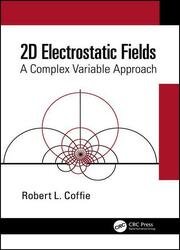 Название: 2D Electrostatic Fields: A Complex Variable Approach Название: 2D Electrostatic Fields: A Complex Variable Approach
Автор: Robert L. Coffie
Издательство: CRC Press
Год: 2022
Страниц: 387
Язык: английский
Формат: pdf (true)
Размер: 11.4 MB
This book demonstrates how to use functions of a complex variable to solve engineering problems that obey the 2D Laplace equation (and in some cases the 2D Poisson equation). The book was written with the engineer/physicist in mind and the majority of the book focuses on electrostatics. A key benefit of the complex variable approach to electrostatics is the visualization of field lines through the use of field maps. With todays’ powerful computers and mathematical software programs, field maps are easily generated once the complex potential has been determined. Additionally, problems that would have been considered out of scope previously are now easily solved with these mathematical software programs.
For example, solutions requiring the use of non-elementary functions such as elliptic and hypergeometric functions would have been viewed as not practical in the past due to the tedious use of look up tables for evaluation. Now, elliptic and hypergeometric functions are built-in functions for most mathematical software programs making their evaluation as easy as a trigonometric function.
Key highlights in the book include:
2D electrostatics completely formulated in terms of complex variables
More than 60 electrostatic field maps
Comprehensive treatment for obtaining Green’s functions with conformal mapping
Fully worked Schwarz-Christoffel transformations to more than usual number of problems
A full chapter devoted to solving practical problems at an advanced level
Detailed solutions to all end of chapter problems available on book’s website
Although the text is primarily self-contained, the reader is assumed to have taken differential and integral calculus and introductory courses in complex variables and electromagnetics.
Contents:
1. Functions of a Complex Variable
1.1 Complex Numbers and Variables
1.2 Conjugate Coordinates
1.3 Analytic Functions
1.4 Real and Imaginary Parts of Analytic Functions
1.5 Taylor Series
1.6 Multi-valued Functions
1.7 2D Vectors and Vector Operators
1.8 Line Integrals
1.9 Divergence Theorem in 2D
1.10 Curl Theorem in 2D
1.11 Divergence and Curl Theorems in Conjugate Coordinates
1.12 Cauchy’s First Integral Theorem
1.13 Cauchy’s Second Integral Theorem
1.14 Laurent Series
1.15 Classification of Singularities
1.16 The Residue Theorem
1.17 Green’s Identities in 2D
References
2. Electrostatics
2.1 Coulomb’s Law
2.2 Electric Field Intensity
2.3 Electric Fields of Dipoles and Multipoles
2.4 Continuous Charge Distributions
2.5 Gauss’s Law in 2D
2.6 Polarization
2.7 Maxwell’s Equations
2.8 Boundary Conditions
2.9 Electrostatic Potential
2.10 Complex Potential
2.11 Complex Potential for a Dipole
2.12 Complex Potential for a Double Layer
2.13 Transforming Poisson’s Equation into Laplace’s Equation
2.14 Equipotential Contours
2.15 Lines of Force
2.16 Field Maps
2.17 Gauss’s Law for Inhomogeneous Mediums
2.18 Dielectric Boundary Conditions for ф
2.19 Uniqueness Theorem
2.20 Conductors and Insulators
2.21 Capacitance
2.22 Method of Curvilinear Squares
2.23 Energy in the Electrostatic Field
2.24 Green’s Reciprocation Theorem
2.25 Induced Charges on Grounded Conductors
References
3. Line Charges
3.1 The Complex Potential Plane
3.2 Single Line Charge
3.3 Two Line Charges
3.4 ф for Conductor Boundary in Parametric Form 104
3.5 Green’s Function
3.6 Method of Images and Green’s Functions
3.7 Green’s Function for a Conductive Cylinder
3.8 Green’s Function for a Conductive Plane
3.9 Green’s Function for Two Conducting Planes
3.10 Ray Tracing for Planar Dielectric Boundaries
3.11 Ray Tracing for Planar Conductor Boundaries
3.12 Ray Tracing for Planar Line of Force Boundaries
3.13 Ray Tracing for Multiple Planar Boundaries
3.14 1D Array of Line Charges
3.15 2D Array of Line Charges
3.16 Line Charge Between a Grounded Cylinder and a Floating Cylinder
3.17 Line Charge Between Two Grounded Concentric Cylinders
References
4. Conformal Mapping I
4.1 Defining Conformal Transformations
4.2 Transforming Complex Potentials
4.3 Translation
4.4 Magnification and Rotation
4.5 Complex Inversion and Inversion
4.6 Inversion of a Point
4.7 Inversion of a Triangle with Vertex at zc
4.8 Inversion of a Line
4.9 Inversion of a Circle
4.10 Inversion of Orthogonal Circles
4.11 Symmetry Preservation with Inversion
4.12 M¨obius Transform
4.13 Logarithm Transformation
4.14 Riemann Sphere
4.15 Charges at Infinity
4.16 Dielectric Cylinder and Line Charge
4.17 Floating Conductive Cylinder and Line Charge
4.18 Line Charge Between Two Concentric Conductive Cylinders Revisited
4.19 Nonconcentric Cylinders to Concentric Cylinders
References
5. Conformal Mapping II
5.1 Riemann Mapping Theorem
5.2 Symmetry of Conformal Maps
5.3 van der Pauw Theorem
5.4 Thompson-Lampard Theorem
5.5 Schwarz-Christoffel Transformation
5.6 S-C Transformation with bn = 1
5.7 S-C Transformation onto a Unit Disk
5.8 Phase of A1
5.9 Exterior Angle for a Vertex at Infinity
5.10 Boundary Condition for Parallel Lines that Meet at Infinity
5.11 Polygons with Both Vertices at Infinity
5.12 Polygons with One Finite Vertex and One Vertex at Infinity
5.13 Polygons with One Finite Vertex and Two Vertices at Infinity
5.14 Polygons with Two Finite Vertices and One Vertex at Infinity
5.15 Polygons with Two Finite Vertices and Two Vertices at Infinity
5.16 The Joukowski Transformation
5.17 Polygons with Three Finite Vertices
5.18 Polygons with Four Finite Vertices
References
6. Case Studies with Conformal Mapping
6.1 Parallel Plate Capacitor
6.2 Characteristic Impedance of Lossless Transmission Lines
6.3 Charge Imaging on Infinite Plate
6.4 Field Plates
6.5 Trigate FinFETs
6.6 Uniform Electric Field
6.7 Circular Conducting or Dielectric Cylinder in a Uniform Electric Field
6.8 Elliptic Dielectric Cylinder in Uniform Electric Field
6.9 Limitations for conformal mapping
6.10 Conclusions
References
Chapter 7. Other Fields of Physics
7.1 Translating to Other Areas of Physics
7.2 Steady Electric Current
7.3 Magnetostatics
7.4 Steady Heat Power Flow
7.5 Fluid Dynamics
References
Appendix A. Differentiating an Integral
Appendix B. Dirac □-Function
Appendix C. Elliptic Integrals
Appendix D. Jacobi’s Elliptic Functions
Appendix E. Gamma and Beta Functions
Appendix F. Gauss’s Hypergeometric Function
Appendix G. Dilogarithm and Trilogarithm Functions
References
Index
Скачать 2D Electrostatic Fields: A Complex Variable Approach
|